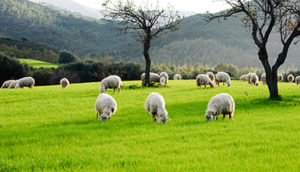Read the latest information on
Foot-and-mouth disease
 When buying livestock, value for money is the first and foremost concern, as producers want to know that the stock they are purchasing will be productive and profitable.
When buying livestock, value for money is the first and foremost concern, as producers want to know that the stock they are purchasing will be productive and profitable.
One part of this is ensuring they come from a reputable source. The other part is ensuring that they are free of diseases and conditions which may impact their productivity.
For stock agents handling sheep sales, the national Sheep Health Declaration (SHD) is available to help their clients capture and record information about the health of the sheep being consigned and pass that information along to potential buyers.
“With an SHD, a buyer can make an informed choice regarding the health status of the sheep they wish to purchase,” said Dr Rob Barwell, Animal Health Australia’s Senior Manager Biosecurity.
“This will empower them to make arrangements for managing the arrival of the new sheep and their integration into their flock, as well as their strategy for managing these sheep in the future.”
The SHD includes a range of questions regarding common conditions which may be present in the flock of origin, or be under active management, including footrot, ovine brucellosis and Johne’s disease.
It also includes an opportunity for the vendor to record information about the most recent treatments for internal and external parasites, ensuring treatments are used appropriately to help avoid resistance.
“The SHD is recommended for Livestock Production Assurance purposes and we strongly encourage producers to always request a completed declaration when buying sheep, or proactively provide this information when looking to sell,” Dr Barwell explained.
“As the primary conduits between vendors and purchasers, stock agents are in an enviable position to ensure that animal health, welfare and biosecurity are central to the conversation any time that sheep change hands.”
With the SHD being included in the eNVD portal and as a key requirement of selling through AuctionsPlus it’s now easier than ever to prompt a vendor to fill in the Declaration, or assist them in doing so.
It is also available through Farm Biosecurity as both a digital and printable form.
“While agents may assist their clients in filling in the form, it’s important to note that, as they’re making a legal declaration, the vendor must be the one to sign on the dotted line,” said Dr Barwell.
Additionally, with New South Wales and Queensland making biosecurity a legal obligation for anyone involved in the livestock production or supply chains – and with more states likely to follow suit – it’s vital that stock agents take the time to discuss animal health and biosecurity with their clients.
“Purchasing and introducing new livestock is one of the most significant ways that diseases spread to new flocks,” Dr Barwell explained.
“It’s in everyone’s interest that stock agents, saleyards and transporters play a role in ensuring the health and welfare of individual flocks, for the sake of the industry nationwide.”
For more information on the Sheep Health Declaration, visit the Farm Biosecurity website.